Maa ki Dal recipe with step by step photos. At home all my folks are fond of black lentils (black gram or kali urad dal) or Punjabi kali dal recipe. This delicious and creamy Punjabi lentil dish is made with whole black gram (sabut urad dal), onions, tomatoes and the usual Indian spices. Comforting, filling and satisfying meal when served with phulka, roti, paratha or naan.
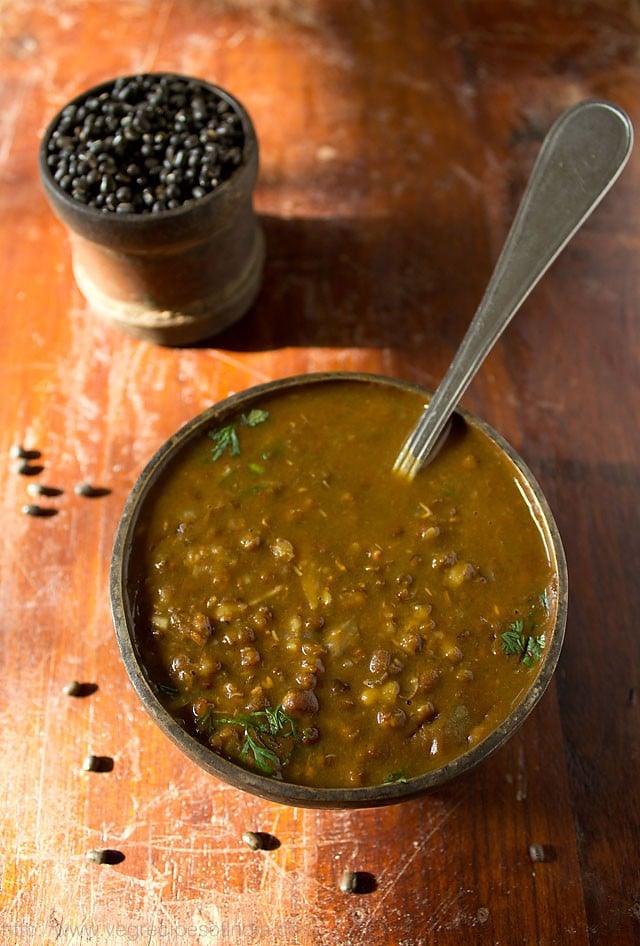
In Punjabi these lentils are called Mah di dal or maa di dal or manh di daal. At home everybody called whole black lentils as maa di dal.
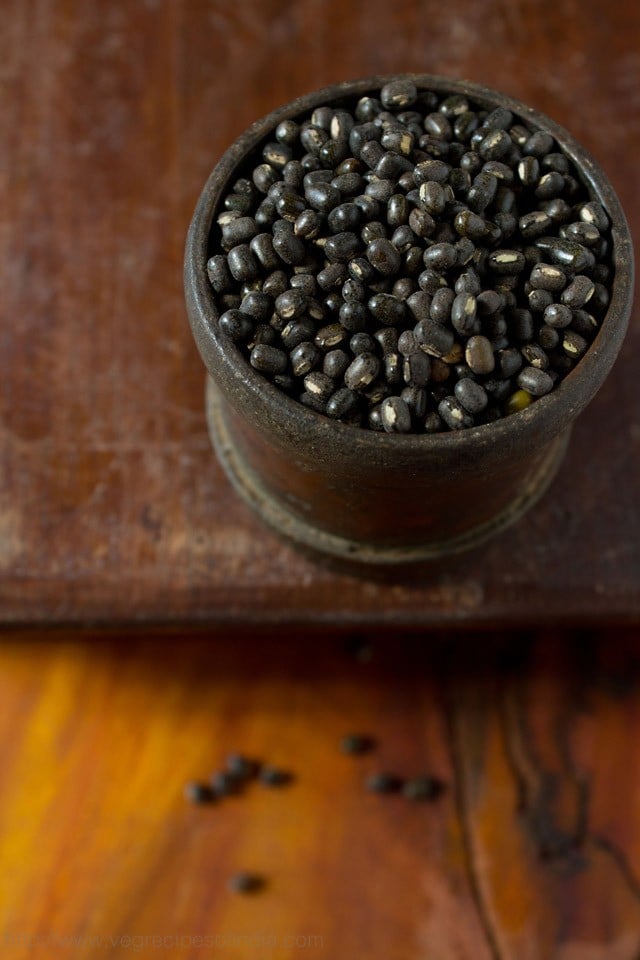
Maa ki dal is also known as kali dal, but it is not dal makhani. So let me tell you what is the difference between maa ki dal and dal makhani.
Maa ki dal or kali dal is made from whole black grams (black dal or kali urad dal or sabut urad dal) only. There are many ways of making this black gram dal recipe. It can be spicy or less spiced as well. It is also not a very rich and heavy dish as no extra cream, butter is added to it.
Whereas Dal Makhani is made from a mix of whole black grams, kidney beans (rajma), and some times chana dal. It is a rich dish as it is made with butter, cream and sometimes yogurt too. It is a makhani dish.
Makhani means buttery. The word makhani is derived from the Punjabi word Makhan which means Butter. So dal makhani is a buttery creamy rich dish.
So kali dal or maa ki dal is not dal makhani. They are two different dishes. Just to let you know there is another Punjabi dish called maa chole di dal – this is made from black lentils and chana dal. It is a staple at my home.
Usually, at home I cook Dal fry, Dal tadka, various sabjis, pulao, khichdi, idli, dosa, sambar. For me these are simple, comforting foods.
This recipe of kali dal is a light recipe with a spicy touch to it. I have made this with sunflower oil and no butter or ghee. For a more richer version you can make it with butter or ghee. You could also add some cream in the end if you prefer.
The main ingredients of this star dish besides whole black gram are onions, green chilies, tomato puree and crushed ginger-garlic sauteed with Indian spices.
Generally maa ki daal is cooked and simmered in a pot. In a modern day life we don’t have the luxury and leisure to let our dals cook in pots. The black lentils take a lot of time to cook in a pot.
I have cooked the dal in a stovetop pressure cooker. It is a quick cooking method and what might take hours, just gets done in 30 to 40 minutes. If you have Instant pot then you can also make this dish in it adding water as needed.
Also remember to use fresh lentils as they cook faster compared to aged lentils. I also recommend to soak the lentils for some minutes prior to cooking. Soaking lentils reduces the cooking time and also helps in getting rid of the phytic acid in them.
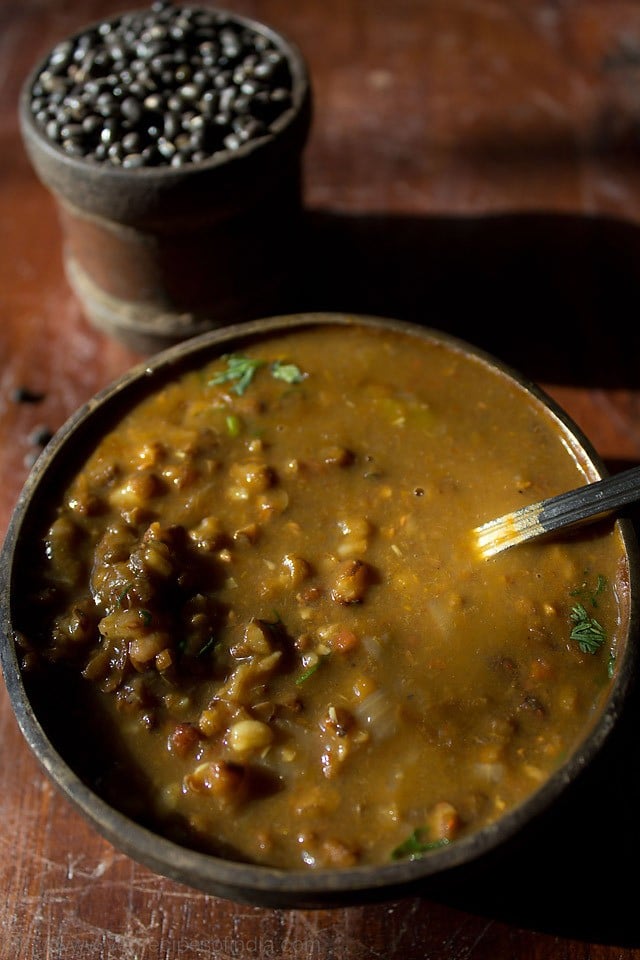
Maa ki dal goes very well with roti, naan and even rice. So if you are fond of Punjabi dishes, then do try this awesome kali dal recipe. You and your family are going to love it. You don’t have to trust me. You have to make this at home and relish the maa di dal.
How to make Kali Dal or Maa ki dal
1: Pick the sabut urad dal (whole black gram with husks), rinse in water for 2 to 3 times. Later drain the water and soak the lentils in enough water in a bowl for about 30 to 40 minutes.
The soaking time can vary depending on the quality and age of the lentils. Sometimes even after soaking for an hour or so, these aged lentils take a lot of time to cook.
So you can soak sabut urad dal overnight or for some 4 to 5 hours. So if using old lentils or lentils near expiry date, soak them overnight. Later, drain the soaked dal.
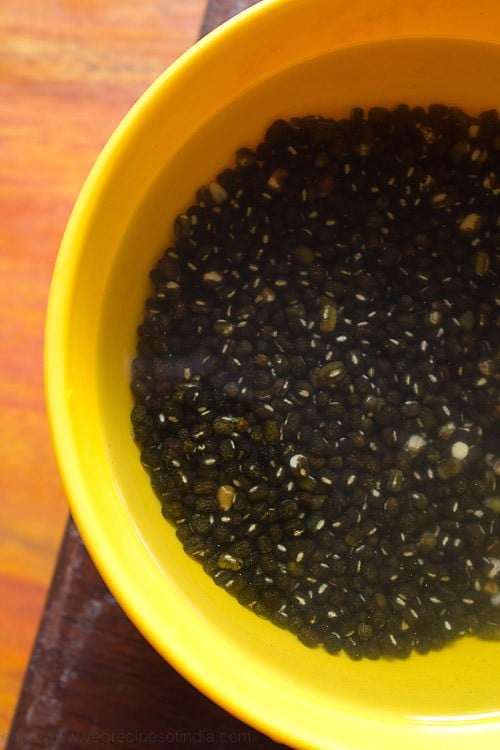
2: Heat 2 tablespoons of ghee or oil in a 3 litre stovetop pressure cooker. Instead of ghee you can also use butter.
Add ½ teaspoon cumin seeds. Keep the heat to low. When they sizzle and crackle, add 1 medium-sized chopped onion (about ⅓ cup chopped onions).
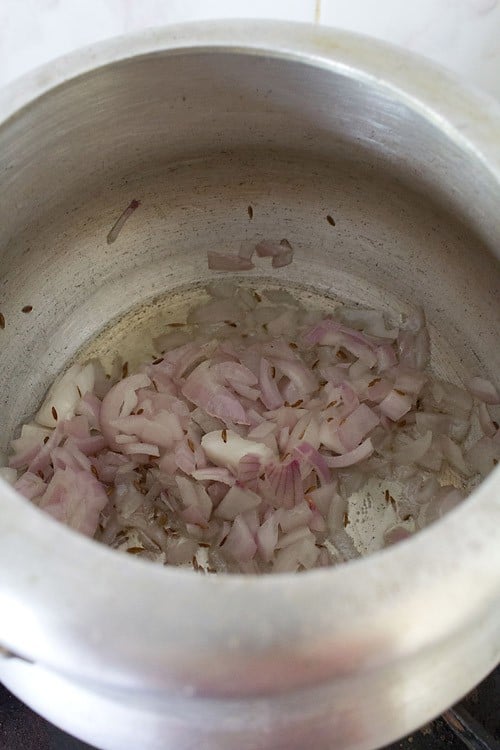
3: Stirring at regular intervals, fry the onions till light brown or golden on low to medium-low heat.
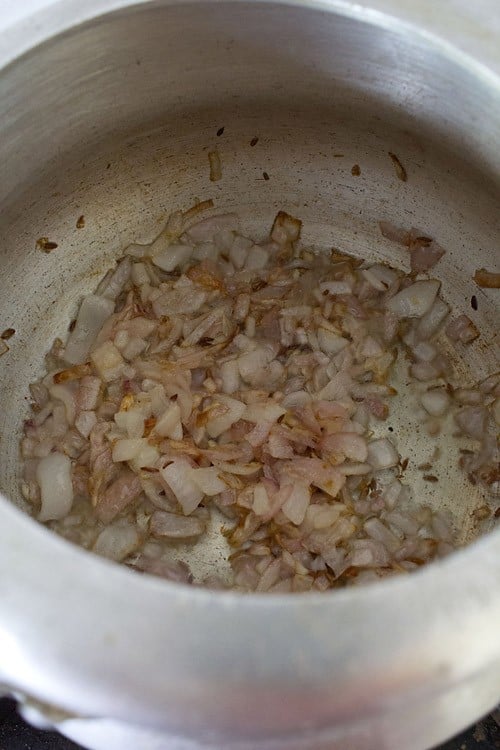
4: Now add the pureed tomatoes. Stir and mix well. I have pureed or blended 2 medium sized tomatoes in a blender and this yields about 1 cup of tomato puree.
You can easily swap fresh tomato puree with canned tomato puree.
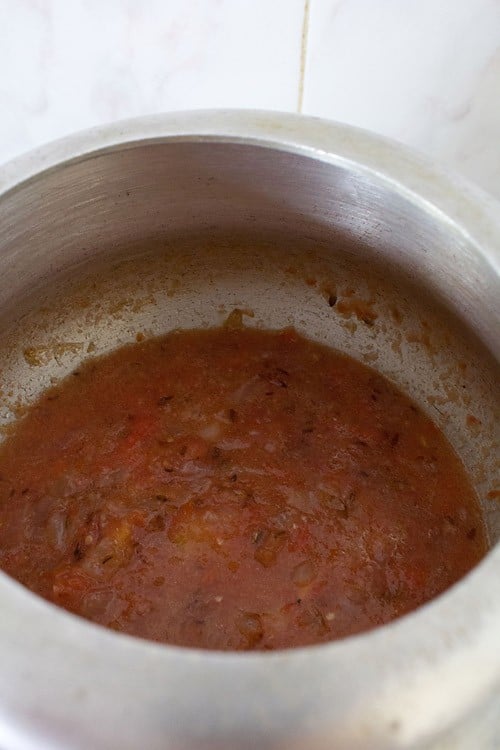
5: Add the crushed ginger and garlic – about 3 to 4 small to medium-garlic cloves and 1 inch ginger crushed in a mortar-pestle. Or add 2 teaspoons ginger-garlic paste instead.
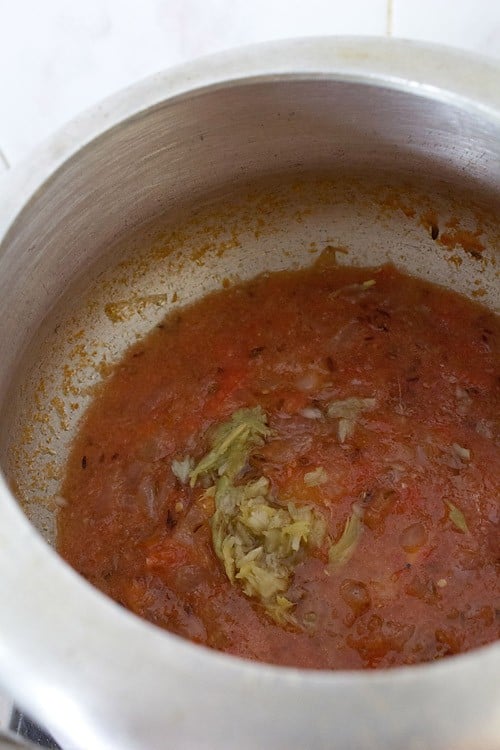
6: Add all the dry spice powders. In this below photo I have added the following ground spices one by one:
- 1 teaspoon coriander powder
- ½ teaspoon turmeric powder
- ½ teaspoon red chili powder
- ¼ teaspoon garam masala powder
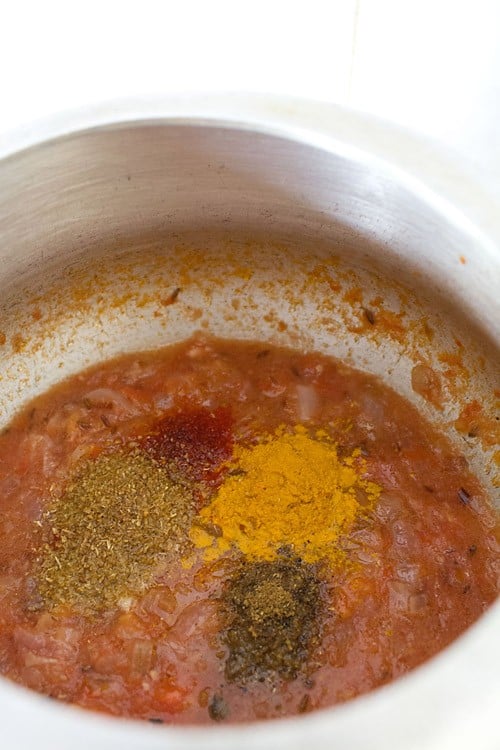
7: Stir the spice powders and mix well.
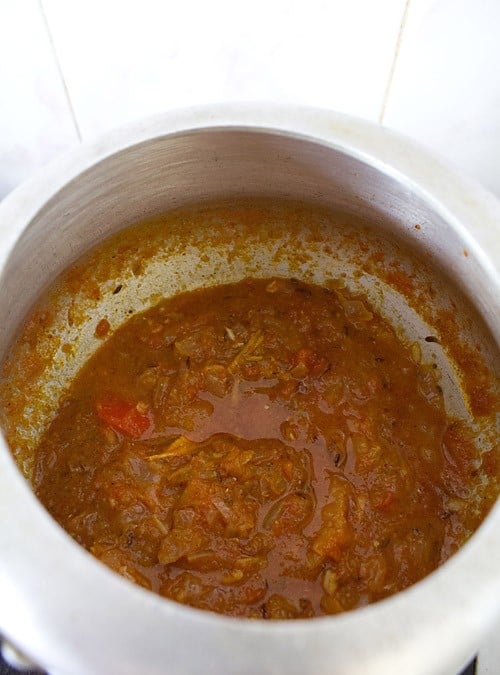
8: Then add 1 finely chopped green chili or ½ to 1 teaspoon chopped green chillies.
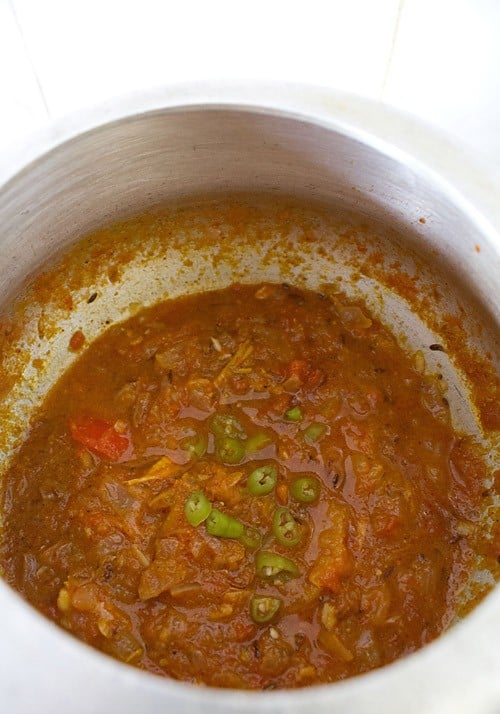
9: Sauté the masala stirring often on a low to medium-low heat till the oil starts to leave or separate at the sides. Take care the masala does not burn while sautéing.
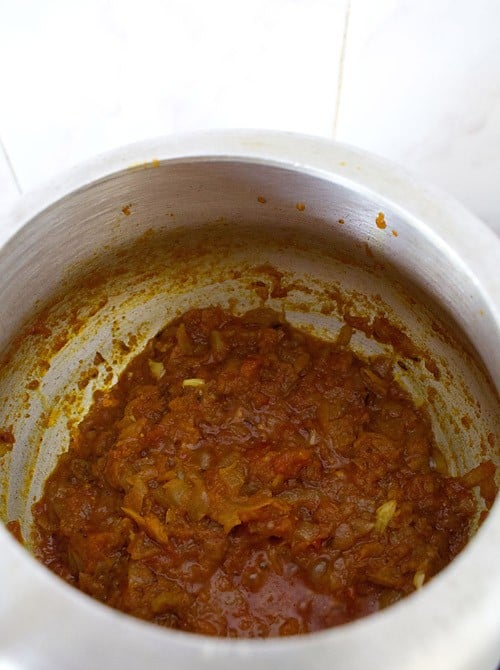
10: Add the drained and soaked sabut urad dal (black gram).
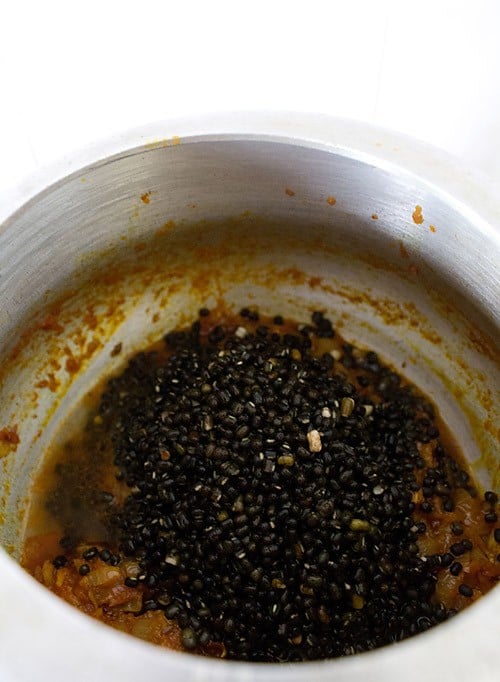
11: Add 3 to 3.5 cups of water and salt as required. Stir and mix well.
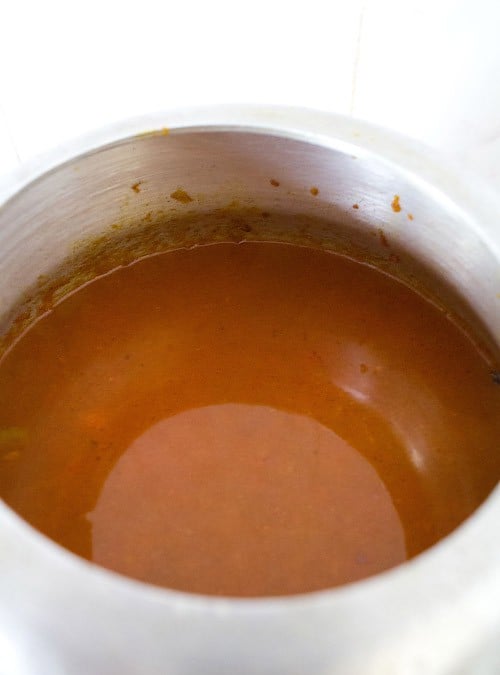
Cover the pressure cooker with its lid and pressure cook the dal for some 20 to 25 minutes on medium to medium-high heat till the lentils are soft, tender and thoroughly cooked. When the pressure falls down naturally in the cooker then only open the lid.
Simmer the lentils on low to medium low heat stirring often. Mash some lentils with the spoon whiles the lentils are simmering. This helps to thicken the consistency of the dal.
Cook and simmer till you get a creamy consistency. I kept the maa ki dal a little thin as we prefer thin dals in summer. You can keep the consistency as per your preference.
Garnish it with coriander leaves and serve maa ki dal hot or warm with naan, kulcha, rotis or plain paratha. You can also have it with steamed basmati rice.
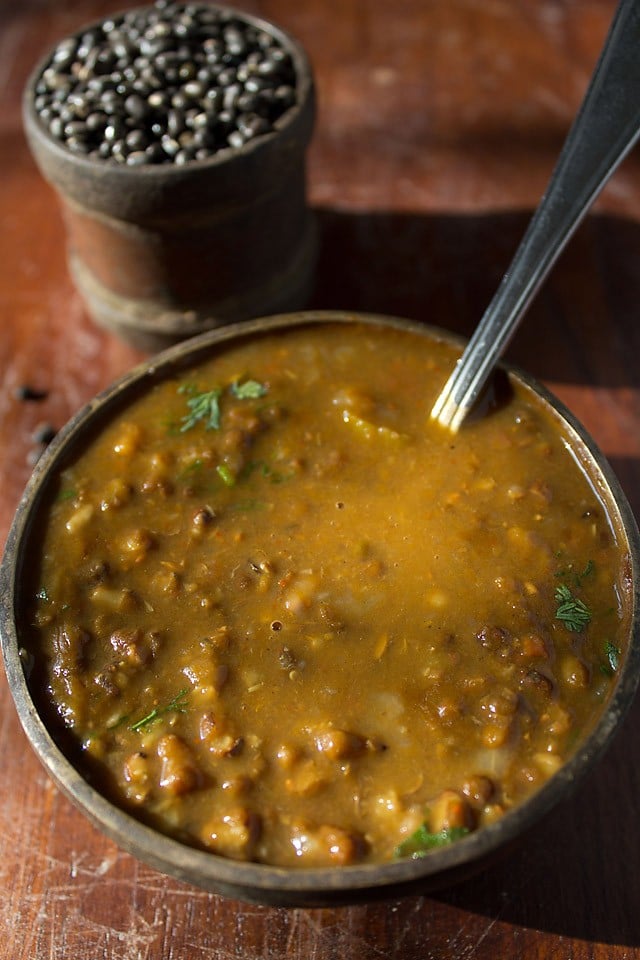
Please be sure to rate the recipe in the recipe card or leave a comment below if you have made it. For more vegetarian inspirations, Sign Up for my emails or follow me on Instagram, Youtube, Facebook, Pinterest or Twitter.
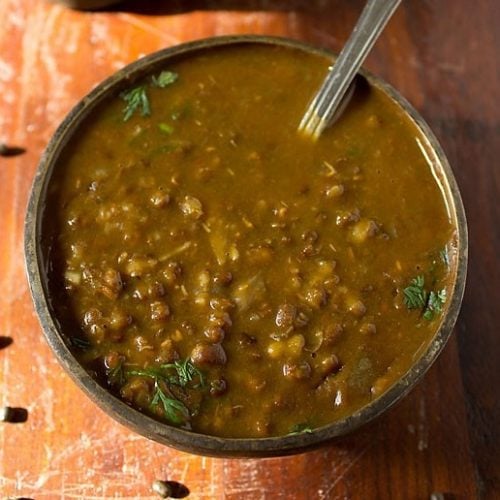
Kali Dal | Punjabi Black Dal (Maa Ki Dal)
Ingredients
- 1 cup whole black lentils (sabut urad dal or black gram)
- 1 medium onion – chopped or ⅓ cup chopped onions
- 2 medium tomatoes pureed – yields approx 1 cup tomato puree
- 2 to 3 garlic cloves small to medium – crushed in a mortar-pestle
- 1 inch ginger – crushed in a mortar-pestle
- 1 green chili – finely chopped or ½ to 1 teaspoon chopped green chillies
- 1 teaspoon Coriander Powder (ground coriander)
- ½ teaspoon cumin seeds
- ½ teaspoon turmeric powder (ground turmeric)
- ½ teaspoon red chili powder (or cayenne pepper or paprika)
- ¼ teaspoon Garam Masala
- 2 tablespoons oil or ghee or butter
- 3 to 3.5 cups water or add as required
- salt as required
- 1 to 2 tablespoons coriander leaves for garnishing, optional
Instructions
Soaking Lentils
- Pick the sabut urad dal and rinse in water for 2 to 3 times and soak it in water for 30 to 40 minutes. You can also soak the lentils for 4 to 5 hours or overnight, depending on the quality of dal. If the lentils are old or near expiry date, then soak overnight.
- Later drain the soaked sabut urad dal.
Making maa ki dal
- Heat ghee or oil in a 3 litre stovetop pressure cooker. Instead of ghee you can also use butter. Keep the heat to low. Add the cumin seeds. When they sizzle and crackle, then add chopped onions.
- Fry the onions stirring often till light brown or golden on low to medium-low heat.
- Add the pureed tomatoes. Stir and mix well.
- Next add the crushed ginger-garlic or ginger-garlic paste.
- Add the all the dry spice powders – coriander powder, turmeric powder, red chili powder and garam masala powder. Stir the spice powders and mix well.
- Add chopped green chilies.
- Saute the masala on a low to medium-low heat till the oil starts to leave or separate at the sides. Ensure that the masala does not burn while sauteing.
- Add the soaked sabut urad dal (black gram). Add water and salt as needed. Stir and mix well.
Cooking maa ki dal
- Cover the pressure cook for about 15 to 18 whistles or 18 to 20 minutes or till the lentils have become soft and buttery. If still they are not cooked well, then continue to pressure cook for a few more whistles.
- When the pressure falls down naturally in the cooker then only open the lid.
- If the dal looks thin, then simmer without the lid, till it reaches the desired consistency.
- Garnish with coriander leaves.
- Serve maa ki dal hot with naan, kulcha, rotis, plain paratha or plain boiled rice.
Nutrition Info (Approximate Values)
This Black Dal recipe from the blog archives first published in April 2012. It has been republished and updated on January 2022.
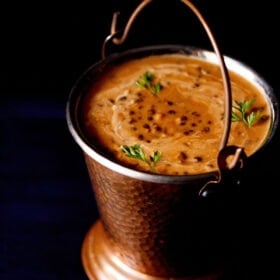
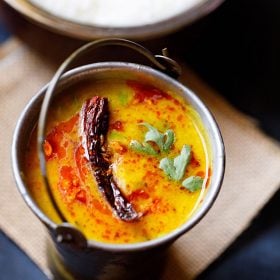
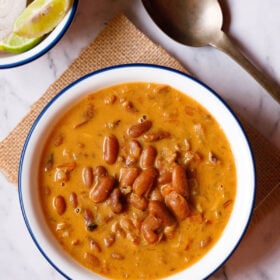
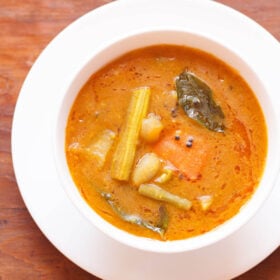








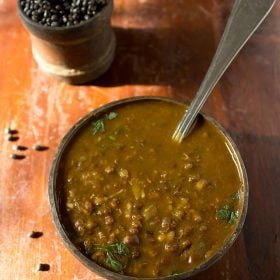
Very good and tasty recipe.👍👍👍
I made a comment the other day – you don’t seem to have received it. I’ve signed up for your beginner’s guide and I’m very excited about it! I cook with cast iron pans and I wondered if there was anything more I needed to know cooking this way. I am about to make the Ma Ki Dal and I know it will be good! Thank you!
Hello Dassana! I live in France and I’ve just come across your very exciting blog! I have 2 questions:
Can this Dahl be made with green lentils (easier to find)? I don’t use a pressure cooker – most of my cooking is done in a cast iron pot.
Does this matter? I wouldn’t think so but I’d like to be sure.
For green lentils, you can have a look at this recipe of Green Lentils which has a different flavor and taste than this one.
Green lentils can be easily cooked in a pot. Even these lentils can be cooked in a pot. But remember to soak them for some 4 to 5 hours or overnight. In fact lentils cooked in a pot taste better than the pressure cooked lentils.
Tried yesterday, it was really awesome.. The taste was so good, I can’t explain in words. I am following your recipes since long and found each one worthy for me. Thank you.
Thanks so much and so glad to know. Thanks for the rating also on the recipe. Most welcome.
I will try soon. Explained very clearly, thank you
Thanks.
I’m going to try this soon. I love your explanations, and I look forward to trying more of your recipes. Thanks!
Thanks a lot and I hope you like the recipes.
I have not tried the recipe yet because I have a question–could I make this in a crock pot? It seems like I could start the beans and then add the savories during cooking. What do you think?
I am excited to start making more Indian food and have signed up for your emails!
Yes you can do that. Recipes like these can be made in the crock pot. Do let me know how it goes for you. Thank you.
Hi Dassana, thank you for this post. It’s incredible. I just made it step by step! And it’s so creamy and delicious!
I’ve never used a pressure cooker before, I had to give a couple of tries, but I called mum and she helped me! The daal is insane! Thank you again.
Hi Nim, thanks for the super feedback on the recipe and also thanks sharing your experience making this recipe. Glad that your mom helped. Most welcome.
Absolutely delicious! I added a teaspoon of plain Greek yogurt to my bowl when I ate it. Amazing combination of spices.
Thanks a lot.
Thank you for posting such amazing recipes with simplified steps which are so easy to follow. I only started cooking now and your blog has been my teacher. Any dish I think of I first some here to check if you have the recipe and I have almost always found what I am looking for as your collection is so comprehensive. Sincere thanks for your efforts and may your blog continue to keep inspiring and guiding novice cooks like me.
Thanks a lot Madhu. Felt nice to read your lovely comment. I am glad that the recipes are helpful during these times. Thanks again and I wish you all the best. Stay safe and take care.
I have tried a lot of your recipes and every recipe has come out really well 😊
Your blog is my favourite whenever I am cooking anything vegetarian.
Thanks a lot Grishma and glad to know. Happy Cooking.
Very good in taste
Thanks for the feedback.
Dear Dassana,
You really are awesome cook. I love following your recipes.Its always a hit when I have parties at my house. Keep it up you are doing awesome job with step by step explanation of each recipes.
Reena
Thanks a lot Reena and I am glad that you have liked the recipes. Thanks for sharing your feedback. Stay Safe.
Dear Dassana,
Is there a particular reason why after frying the onion, you add the tomato puree first and then the ginger and garlic and not the other way around, as in most of your recipes? Just curious ???? Thanks!
hi esther, there is no particular reason. you can add it either way. the taste will be same – the ginger-garlic just need to be sauteed and cooked well. welcome and hope this helps.
Hi
I wish to cook this in slow pressure cooker or instapot
Can you sugges how much time I would need
Thanks
hi padmaja., i recently made dal makhani slow-cooked in instant pot. i kept for a time of 12 hours as even after 9 hours the lentils were not softened. initially, i had kept for 9 hours but then increased the time. i had used presoaked lentils. i would suggest you to make this maa ki dal in a slow cooker and not an instant pot. the reason is that an instant pot does not slow cook as good as compared to a slow cooker. it is best for pressure cooking. in a slow cooker, you can keep for 8 hours. hope this helps.
is sabut masoor daal also called ‘ma ki daal’? Because in some parts of UP, masoor daal is said to symbolise a goddess (ma) … and could ‘ma ki daal’ also have a similar origin?
as far as i know, sabut masoor dal is not called as maa ki dal. i have read about masoor dal symbolizing the goddess. could be that maa ki dal has a similar origin, that we are not aware of. in fact, urad dal is originally from india and is mentioned even in the ancient texts.